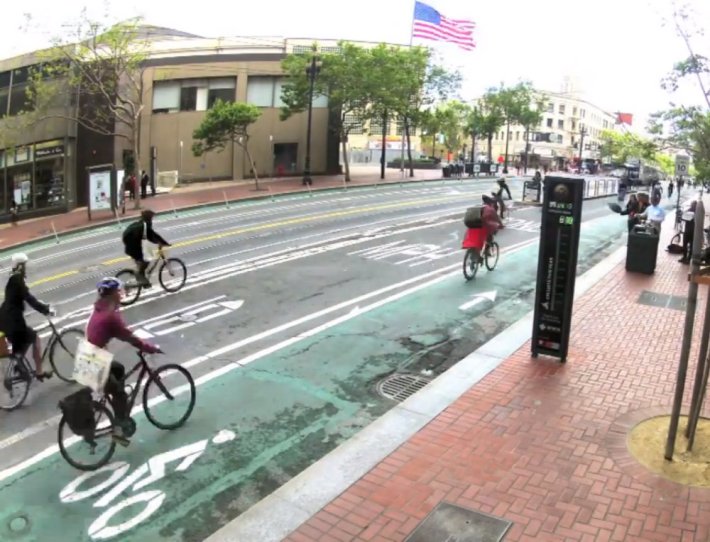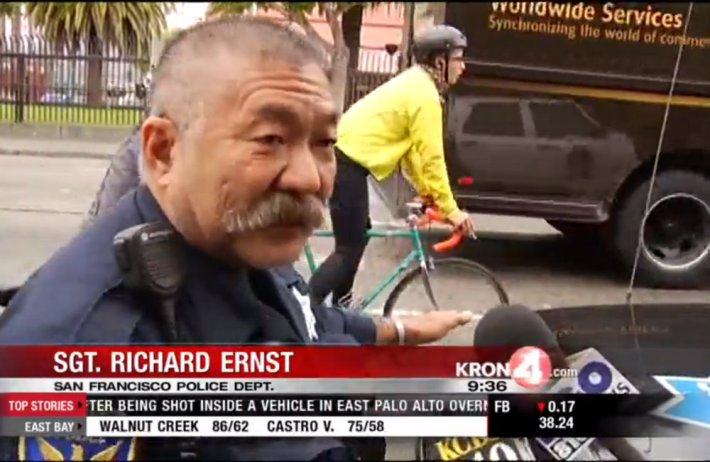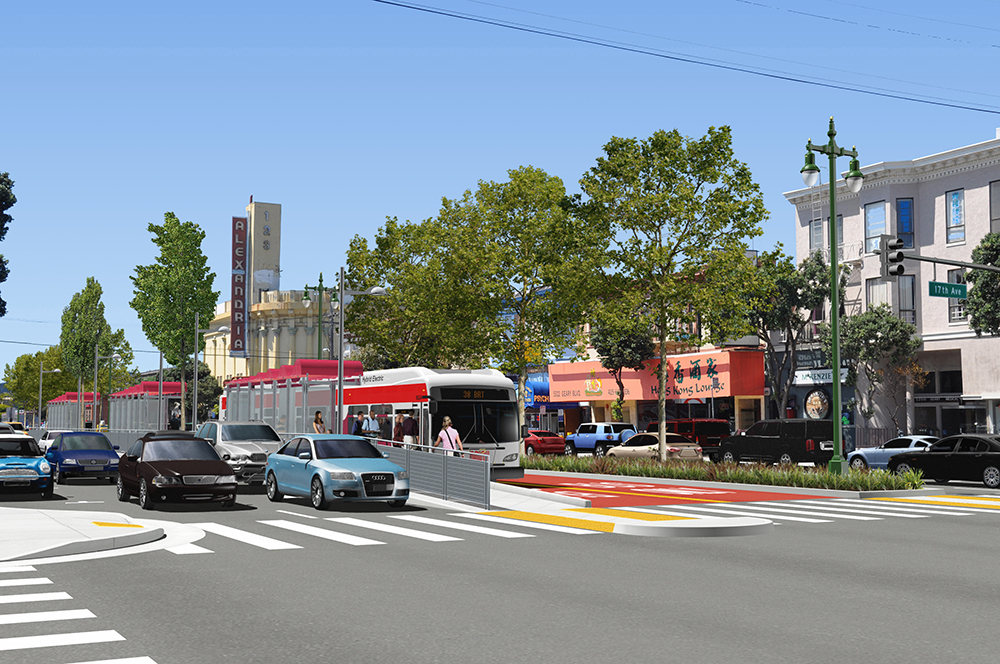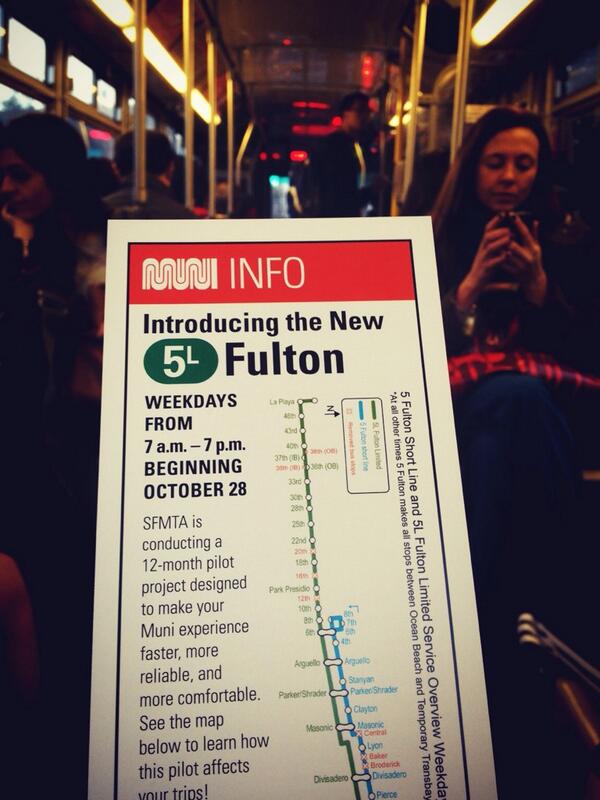The 2013 Streetsie Awards, Part 2
5:29 AM PST on January 1, 2014

Today we bring you the second and final round of Streetsblog San Francisco's 2013 Streetsie Awards, highlighting the best and worst in livable streets from the past year. This round will start out with a focus on the worst.
Worst Statement From a City Official
As a representative of the San Francisco Police Department, Sergeant Richard Ernst could have chosen a different way to approach the folks at the memorial held where 24-year-old Amelie Le Moullac was killed on her bike at Folsom and Sixth Streets. He could have expressed sympathy for Le Moullac and the other three victims who were killed by truck drivers this year through no apparent fault of their own, or shown support for safety improvements on SoMa streets, as advocates at the scene were calling for that day.
Instead, Ernst purposefully parked his police cruiser in the Folsom bike lane where Le Moullac was killed, to make a point of blaming her and everyone else killed on bikes, saying it was his "right" to do so. Later, video footage found at the same scene by an SF Bicycle Coalition staffer would show that the trucker who killed Le Moullac made an illegal right turn. The SFPD apparently didn't bother to check for that video themselves.
Chief Greg Suhr later apologized. But it was too late to take back what Ernst had done. Speaking in full view of the mourners and broadcast news reporters, Ernst's actions struck a nerve for many victims of less public cased of SFPD anti-bike hostility. His stunt would ultimately spark interest at City Hall in looking into the broader problem -- in October, dozens of bicycle riders came forward to share horrific stories at a hearing called by Supervisor Eric Mar.
NIMBYs of the Year
Save Polk Street blew the other NIMBYs out of the water this year. Perhaps their most notorious stunt was to invite out-of-towners to pack a neighborhood meeting and fight for car parking on Polk, safety improvements be damned. The merchant group's leaders spread fear to galvanize opposition, making up stories about failed bike lanes in other cities. One bookstore owner blamed Polk's existing bike lanes for a drop in business while, in the same breath, claiming that the street is busier than ever. The group has continued to dismiss the SFMTA's study which found that 85 percent of people on Polk arrive without a car.
Unfortunately, Save Polk Street's fearmongering partially succeeded, persuading the SFMTA and Supervisor David Chiu -- purportedly a champion of safer streets for biking -- to roll back safer bike lanes in favor of parking in the Polk plan. The project still has to be approved by the SFMTA Board of Directors, which wants the option of a full bike lane pilot, but the current proposal is a far cry from the original vision of parking-protected bike lanes along this vital corridor.
It's a troubling precedent when the city caves on safer streets to appease parking-obsessed NIMBYs. All opponents have to do, apparently, is get enough people to yell loudly along with them.
Most Frustratingly-Delayed Project
Geary Bus Rapid Transit was originally supposed to open in 2012. The current opening date of 2018, believe it or not, was an improvement over the previous one of 2020. But the currently proposed plan will only have center-running transit lanes in the Richmond.
The delays were maddening enough to induce Kieran Farr to resign from the Geary BRT Citizens Advisory Committee out of frustration with the repetitive cycle of planning revisions, largely aimed at appeasing Geary merchants who didn't want to lose car parking. (Sound familiar?) Farr said his time on the committee imparted "a severe disappointment during which I have lost trust in America’s regulatory framework to enact effective transit improvements."
Best Boost for Muni
It wasn't all gloom and doom for transit in 2013. SF saw two of the first pilots to come out of the Muni Transit Effectiveness Project on Church Street and the 5-Fulton line.
Church between Duboce Avenue and 16th Street saw San Francisco's first red transit-only lanes for buses (Third Street received the first red transit lanes for light-rail a few years ago). Since they were implemented in March (following a seasonal weather delay), travel times on the J-Church and 22-Fillmore lines have dropped by 5 percent, and the buses and trains are 20 percent more reliable, arriving closer to their scheduled arrival times. Cars can still often be seen in the red lanes, but they're less likely to delay transit.
In October, Muni riders also roundly cheered the launch of the 5-Fulton Limited, a new commute-hour service that came with a package of TEP-type transit upgrades to boost service on the regular 5 line. Some excess stops were removed, some bus stops lengthened, and a road diet was implemented to create wider lanes for buses on a stretch of Fulton. Planners predicted that the 5L should run 11 percent faster than the existing local service (and 17 percent faster on the limited-stop stretch alone). Though the data on improved service isn't in yet, these improvements, in addition to the 2011 two-way conversion of McAllister's eastern stretch to provide a more direct route, mark some of the most robust service upgrades ever brought to a Muni bus line.
Most Promising Vision for Transforming San Francisco
It didn't quite win the "Best Statement" award this year, but we've got to spotlight Mayor Ed Lee's Transportation Policy Director, Gillian Gillett, for calling on the city to "be San Francisco and take down the freeway." Since Streetsblog reported on the idea in January, the public conversation about the city's next freeway removal has gained serious momentum, with the northern spur of 280 being eyed for conversion to a street-level boulevard to help accommodate high-speed rail.
Given the successes of the city's past freeway teardowns, not to mention everything that was preserved by the freeway protests of an earlier generation, the potential for another highway teardown to bring on an urban transformation is clear. And as former Milwaukee mayor John Norquist argued at a forum in September, "If you didn’t want them to build the ones they didn’t build, then why do you want to keep the ones that did get built? It’s time to start talking about a freeway-free San Francisco."

Coolest New Gadget Promoting Bicycling on the Streets
A must-have for any 21st century bicycling city was installed on Market Street in time for Bike to Work Day this year -- a digital bicycle counter, which now displays a tally of the growing number of bike commuters on Market, daily and annually. (It was out of commission for a few months due to a much-overdue street repaving.)
The counter, located at Market and Eighth Streets, currently counts well over 3,000 bikes on a regular day. Finally, we can keep tabs on our progress towards Copenhagenization (Copenhagen's Nørrebrogade sees over 36,000 bikes a day). It also serves another purpose, as a symbol showing bike commuters and passersby that San Francisco values its pedaling public.
Most Exciting Transportation Improvements Coming in 2014
There aren't many major street improvements in the construction pipeline for 2014, but there are a couple of good livable streets projects to look forward to. Starting in January, the busy stretch of Castro Street will be revamped with wider sidewalks, finally bringing the kind of human-scale treatment this famous street deserves. In the summer, the easternmost block of Haight Street will get the city's first contra-flow transit-only lane, along with pedestrian safety upgrades at the intersection with Market and Gough Streets, removing a notoriously slow and unnecessary detour on the 71-Haight/Noriega and 6-Parnassus lines.
Here's to building momentum for more livable streets and better transportation options in San Francisco in 2014. Happy New Year, Streetsblog readers!
Stay in touch
Sign up for our free newsletter
More from Streetsblog San Francisco
Streetsblog SF editor Roger Rudick offers constructive criticism of Chicago’s downtown bike network
"There were blocks that felt very safe and very secure," he said. "But then you're immediately – voom! – disgorged into three lanes of moving traffic with no protection."
Commentary: There is Zero Ambiguity to the West Portal Tragedy
What happened in West Portal was entirely predictable and preventable. The city must now close Ulloa to through traffic and make sure it can never happen again










